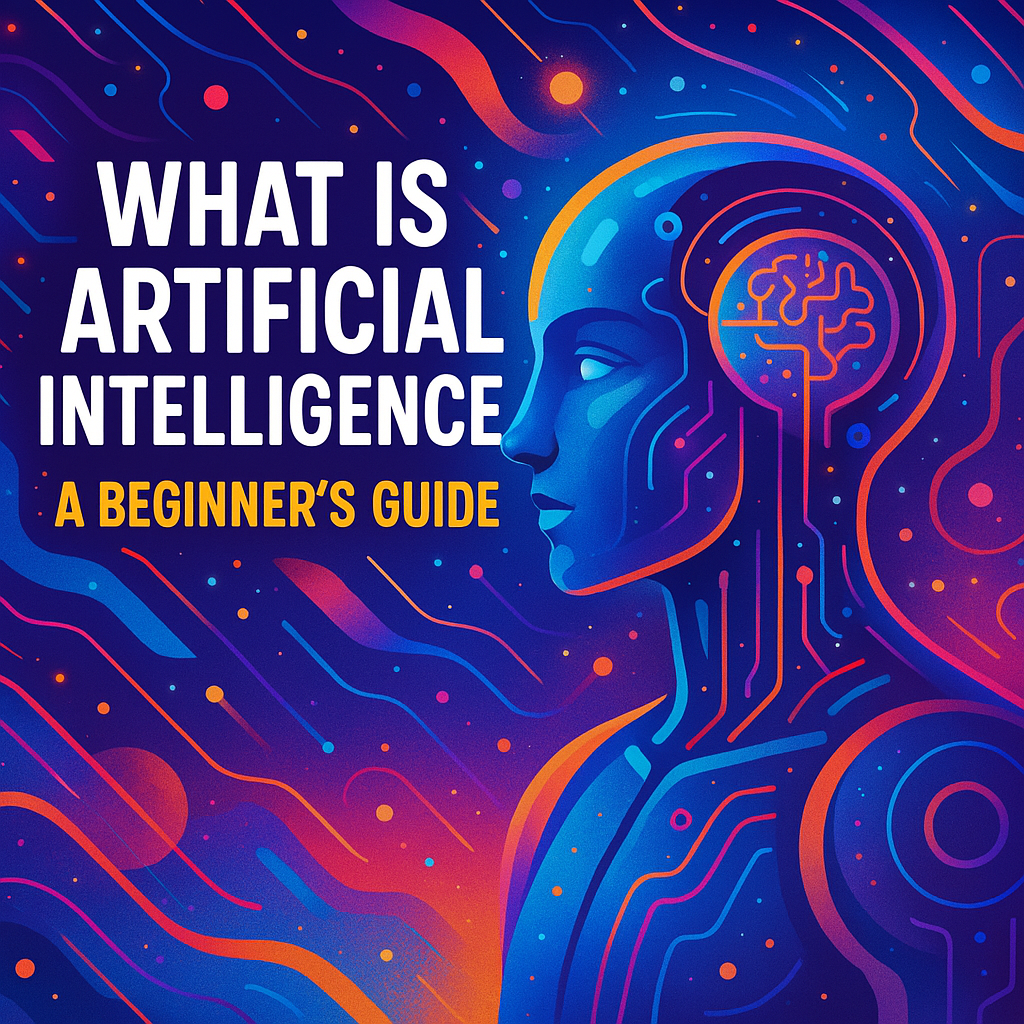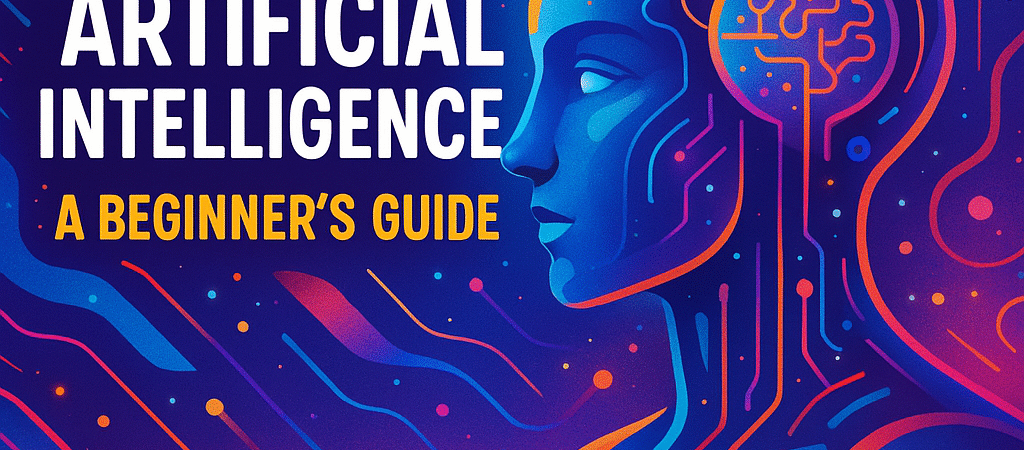Introduction to AI
Have you ever wondered how your smartphone predicts the next word as you type or how virtual assistants like Siri and Alexa understand your voice commands? These everyday experiences are powered by artificial intelligence (AI), a rapidly evolving technology that is transforming industries worldwide. In simple terms, artificial intelligence refers to machines and computer systems designed to simulate human intelligence—enabling them to learn from data, adapt to new information, and perform tasks that typically require human thinking, such as problem-solving, language understanding, and pattern recognition.
AI’s impact is everywhere—from personalized recommendations on streaming platforms and smart home devices to advanced healthcare diagnostics and autonomous vehicles. As AI continues to shape the future of technology, gaining a clear understanding of its fundamentals is essential for anyone looking to stay informed in today’s digital world. This beginner’s guide will walk you through the core concepts of artificial intelligence, including the differences between narrow AI and general AI, as well as key technologies like machine learning and deep learning.
Additionally, we’ll explore real-world applications of AI and discuss important ethical considerations, such as privacy and job displacement. By the end of this comprehensive guide, you will have a solid foundation to appreciate how AI works and why it matters in modern society. Join us on this journey to demystify artificial intelligence and discover its transformative potential.

Understanding Artificial Intelligence: A Beginner’s Guide
Artificial Intelligence (AI) refers to the simulation of human intelligence processes by machines, especially computer systems. This broad field includes various capabilities such as learning, reasoning, problem-solving, and self-correction. Simply put, AI enables machines to mimic how humans learn from experience, adapt to new information, and perform complex tasks that typically require human intelligence. These intelligent behaviors are achieved through advanced algorithms and extensive data processing.
It is important to clearly distinguish between artificial intelligence, machine learning, and deep learning—three closely related but distinct concepts. Artificial intelligence is the overarching discipline focused on creating smart machines capable of performing tasks that usually require human intellect. Machine learning (ML), a vital subset of AI, involves training systems to learn from data and improve their performance autonomously over time without being explicitly programmed. Deep learning (DL), a further specialized branch of machine learning, leverages artificial neural networks to analyze large volumes of unstructured data such as images, audio, and text, closely mimicking the human brain’s learning process. For instance, while machine learning algorithms can identify patterns in structured data, deep learning models excel at interpreting complex data types like speech and visual content.
The history and evolution of artificial intelligence date back to the mid-20th century, marked by key milestones that shaped the field. The term “Artificial Intelligence” was officially coined in 1956 during the Dartmouth Conference, widely recognized as the birth of AI as an academic discipline. Since then, AI has undergone several transformative phases, including the development of expert systems in the 1970s, which applied AI techniques to solve specialized problems. The 21st century has witnessed a resurgence in AI research and applications, driven by exponential growth in computing power, availability of big data, and breakthroughs in machine learning and deep learning technologies. Today, artificial intelligence plays a pivotal role across multiple industries such as healthcare, finance, transportation, and more, revolutionizing how we interact with technology and fundamentally transforming business operations and everyday life.
How Artificial Intelligence Works: Beginner’s Guide to AI
Artificial Intelligence (AI) functions by mimicking human cognitive processes such as learning, reasoning, and problem-solving through advanced computer systems. At its core, AI depends on data input, which it uses to learn and make intelligent decisions. Think of it like training a dog to perform tricks: initially, the dog does not understand the commands, but by rewarding desired behaviors, it learns to associate actions with positive outcomes. Similarly, AI systems rely on vast amounts of data to detect patterns and make predictions or decisions based on that information.
The learning process in AI is driven by algorithms—mathematical models that enable machines to analyze and interpret data. During the training phase, AI systems process large datasets (for example, thousands of images of cats and dogs) to identify distinguishing features that separate one category from another. This extensive training is crucial for AI’s effectiveness, as it allows the system to recognize complex patterns that may not be immediately obvious to humans.
A fundamental element of AI’s functionality is the neural network, an architecture inspired by the human brain’s structure. Neural networks consist of interconnected nodes, or “neurons,” arranged in layers that process information sequentially. As data moves through these layers, the AI system adjusts its internal parameters based on the results it produces, gradually improving its accuracy. Just as a dog becomes better at tricks with practice and reinforcement, AI models enhance their performance through repeated training and fine-tuning.
This ability to learn and adapt makes artificial intelligence incredibly powerful across a wide range of applications, including voice recognition software, autonomous vehicles, and recommendation engines. The more data AI systems access and process, the more proficient they become at making informed decisions, enabling them to solve complex problems with remarkable efficiency and precision.
Types of Artificial Intelligence Explained for Beginners
Artificial Intelligence (AI) can be broadly categorized into three main types based on their capabilities: narrow AI, general AI, and superintelligent AI. Each type has distinct characteristics and serves different purposes across various industries and applications.
Narrow AI, also known as weak AI or Artificial Narrow Intelligence (ANI), is the most common form of AI in use today. This type of AI is designed to perform specific tasks within a limited scope. For example, voice assistants like Siri and Alexa utilize narrow AI to understand user commands and perform designated functions such as setting reminders or playing music. Another everyday example is spam filters in email services, which analyze incoming messages to identify and separate spam from legitimate emails, helping maintain inbox security. Narrow AI excels in automating routine tasks, improving efficiency in sectors like healthcare, finance, retail, and customer service.
In contrast, general AI, also called strong AI or Artificial General Intelligence (AGI), represents a more advanced and theoretical form of artificial intelligence. AGI aims to replicate human-like cognitive abilities, enabling machines to understand, learn, and apply knowledge across a wide range of tasks, similar to a human being. Despite significant progress in AI research, general AI remains largely hypothetical and has not yet been realized. Researchers continue to explore this concept, focusing on developing systems capable of flexible reasoning, problem-solving, and decision-making across diverse contexts.
The third and most advanced type is superintelligent AI or Artificial Superintelligence (ASI). This form of AI would surpass human intelligence in virtually every domain, including creativity, emotional intelligence, and complex problem-solving. While superintelligent AI remains a concept primarily explored in science fiction, it raises important ethical and safety concerns regarding control, autonomy, and the potential societal impact of machines exceeding human cognitive abilities. Discussions about superintelligent AI often highlight the need for responsible AI development to ensure beneficial outcomes for humanity.
Understanding these three types of AI—narrow AI, general AI, and superintelligent AI—provides a foundational framework for grasping the current state and future potential of artificial intelligence technology. As AI continues to evolve, its applications are expanding rapidly, transforming industries such as healthcare, finance, transportation, and entertainment, and reshaping how we live and work.
Artificial Intelligence in Everyday Life: A Beginner’s Overview
Artificial Intelligence (AI) has seamlessly integrated into our everyday lives, profoundly influencing numerous aspects of how we live, work, and communicate—often without us even realizing it. One of the most visible examples of AI in daily life is found in smartphones, where features like voice recognition technology and virtual assistants such as Siri and Google Assistant enhance user experience. These AI-powered tools allow users to perform a variety of tasks through simple voice commands, showcasing the convenience and efficiency that artificial intelligence brings to communication, information retrieval, and personal productivity.
Social media platforms also heavily rely on sophisticated AI algorithms to personalize content for users. By analyzing user behavior, preferences, and interactions, these platforms can suggest new friends, curate customized news feeds, and recommend posts tailored specifically to individual interests. This targeted content delivery not only keeps users engaged longer but also enables companies to optimize their digital advertising strategies by effectively reaching the right audience with relevant ads.
In the realm of online shopping, AI plays a crucial role through advanced recommendation systems. Retailers use AI-driven analytics to suggest products based on a customer’s previous purchases, browsing history, and preferences. This personalized shopping experience not only boosts customer satisfaction but also drives higher sales and conversion rates for businesses. Additionally, AI-powered chatbots and virtual support agents have become essential in customer service, providing instant assistance, answering inquiries, and resolving issues quickly, which significantly reduces wait times and improves overall customer experience.
Beyond consumer applications, artificial intelligence is revolutionizing critical sectors such as healthcare. AI-driven diagnostic tools and machine learning algorithms analyze vast amounts of medical data to improve the accuracy of disease detection and enable earlier intervention. These advancements are transforming patient care and medical research. Moreover, AI is shaping the future of urban mobility through smart transportation systems that optimize traffic management, reduce congestion, and enhance road safety, contributing to more efficient and sustainable cities.
In summary, artificial intelligence is deeply embedded in our daily routines, reshaping how we interact with technology, shop online, receive medical care, and navigate our environments. By driving convenience, personalization, and efficiency, AI is becoming an indispensable part of modern life and a key driver of innovation across multiple industries.
Benefits of Artificial Intelligence (AI) in Business and Daily Life
Artificial Intelligence (AI) has emerged as a transformative technology across various industries, offering numerous benefits that enhance efficiency, productivity, and user experience. One of the most significant advantages of AI is its ability to automate repetitive and mundane tasks, allowing businesses to reallocate human resources toward more strategic and creative activities. This automation not only boosts operational efficiency but also reduces costs. For example, AI-powered systems can manage inventory, schedule appointments, and process transactions, streamlining workflows that traditionally required extensive manual effort.
In addition to automation, AI plays a crucial role in personalizing digital experiences. By analyzing vast amounts of user data and behavior, AI enables companies to tailor their products and services to meet individual customer preferences. This personalized approach improves customer satisfaction and loyalty. E-commerce platforms, for instance, use AI algorithms to recommend products based on past purchases and browsing patterns, creating a more engaging and relevant shopping experience.
AI also excels at solving complex problems by processing large datasets with unparalleled speed and accuracy. In sectors such as healthcare, finance, and scientific research, AI-driven analytics identify patterns and insights that human analysts might miss. This capability enhances disease diagnosis, investment forecasting, and innovation, revolutionizing traditional problem-solving methods.
Moreover, AI significantly improves convenience in everyday life. Tools like smart assistants (Siri, Alexa) and advanced language translation apps simplify daily tasks and improve accessibility. These AI-powered technologies enhance how people interact with devices, making technology more user-friendly and efficient.
In summary, the benefits of artificial intelligence include increased efficiency through automation, personalized customer experiences, advanced problem-solving capabilities, and enhanced convenience. As AI technology continues to evolve, its role in streamlining processes and enriching user interactions will expand, solidifying its importance in modern society and business123456.
Challenges and Ethical Concerns of Artificial Intelligence
Despite its many advantages, the rapid advancement of artificial intelligence brings significant challenges and ethical concerns that must be addressed. One of the most pressing issues is the risk of job displacement due to AI-driven automation. As AI systems increasingly perform routine and repetitive tasks, many traditional jobs—especially in manufacturing, data entry, and administrative roles—face obsolescence. While automation improves productivity and reduces costs, it also raises concerns about economic inequality and workforce transitions.
Another critical challenge is the potential for bias in AI decision-making. AI systems learn from historical data, which may contain inherent biases or inaccuracies. If not properly managed, AI can perpetuate and amplify these biases, leading to unfair outcomes in sensitive areas such as hiring, law enforcement, and lending. Ensuring ethical data sourcing, transparency, and bias mitigation is essential as AI becomes more integrated into society.
Privacy concerns are also paramount in the AI era. The extensive collection and analysis of personal data increases the risk of data breaches and misuse. Protecting sensitive information and establishing clear regulations on data use are vital to maintaining public trust. Furthermore, as AI systems gain autonomy, ethical questions arise about human control, accountability, and the moral implications of AI decisions. Discussions about AI consciousness and responsibility challenge existing frameworks of agency and governance.
Addressing these challenges requires collaboration among policymakers, technologists, and society to develop ethical AI frameworks that prioritize human welfare, equity, and safety. Responsible AI development is crucial to harnessing AI’s benefits while mitigating its risks
The Future of Artificial Intelligence (AI): Emerging Trends and Responsible Innovation
The future of artificial intelligence (AI) promises to be highly transformative across multiple industries, driven by cutting-edge trends such as generative AI, advancements in robotics, and the growing potential for meaningful human-AI collaboration. Generative AI, which involves algorithms capable of creating original text, images, music, and other content, is revolutionizing content creation by augmenting human creativity. This innovation opens new possibilities for media, marketing, and entertainment while also raising important questions about authorship, originality, and intellectual property rights.
In the field of robotics, significant progress has enabled machines to go beyond repetitive tasks to perform complex activities that require adaptability, learning, and decision-making. This evolution facilitates the integration of AI-powered robots in sectors like manufacturing, healthcare, and customer service, improving operational efficiency and delivering more personalized experiences. As robots become increasingly capable of understanding and responding to human needs, the concept of collaborative robots (cobots) is reshaping workflows and enhancing productivity across various domains.
Beyond traditional applications, AI’s impact extends into critical areas such as education and climate science. In education, AI-driven personalized learning platforms tailor educational content to individual student needs, promoting inclusivity, engagement, and accessibility. In climate science, AI technologies analyze massive datasets to model climate change, forecast environmental disasters, and develop targeted sustainability solutions, playing a vital role in global efforts to combat environmental challenges.
Despite these promising advancements, the future of AI must be approached with a strong emphasis on ethical responsibility. Addressing issues such as algorithmic bias, transparency, and data privacy is essential to ensure the safe and fair deployment of AI technologies. As AI becomes increasingly integrated into our daily lives, fostering a balanced dialogue around its benefits and challenges is critical. Responsible AI development and governance will be key to unlocking AI’s full potential while safeguarding societal values.
Conclusion: Understanding the Role and Impact of Artificial Intelligence Today and Tomorrow
Throughout this blog post, we have explored the comprehensive landscape of artificial intelligence (AI) and its growing importance in modern society. Starting with a clear definition, we examined the different types of AI, including narrow AI and general AI, as well as foundational concepts like machine learning and neural networks. These technologies empower AI systems to process vast amounts of data, learn from experience, and make autonomous decisions—capabilities that are revolutionizing industries such as healthcare, finance, and transportation.
We also addressed the critical ethical considerations surrounding AI, particularly in areas of privacy, bias, and accountability. As AI becomes more embedded in everyday applications, it raises important questions about its impact on workforce dynamics, social interactions, and decision-making processes. AI is not just a tool but a transformative force shaping the future of how we live and work, underscoring the need for responsible innovation and deployment.
Furthermore, AI has the potential to enhance human capabilities by automating routine and repetitive tasks, freeing individuals to focus on more complex, creative, and strategic activities. This shift drives innovation and improves overall quality of life. However, the rapid advancement of AI also calls for continuous scrutiny and open dialogue to ensure that its benefits are maximized while its risks are effectively managed.
As we consider the expanding role of AI in our lives, a crucial question emerges: How much do we trust AI systems to assist us in daily decision-making? This question invites a broader conversation about our evolving relationship with technology and the future of trust in human-machine interactions. Your perspectives on this topic are invaluable in shaping the ongoing discourse around AI integration and its societal impact. What are your thoughts?

